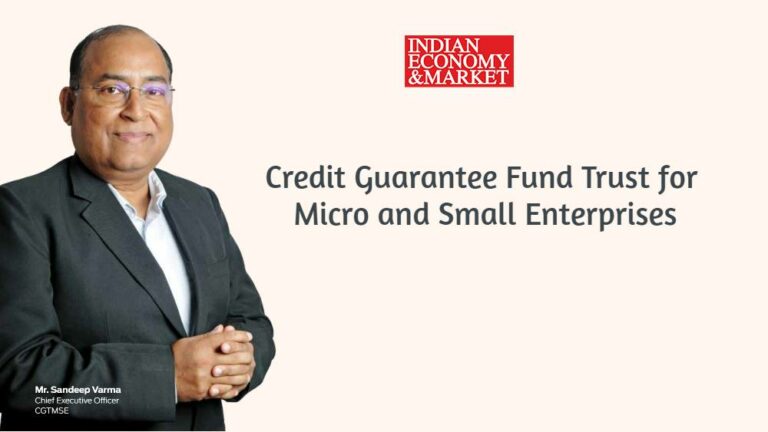With so much happenings at several fronts on the globe, right now India stands as a rare bright spot. Many are looking at India to drive the global economic recovery. India is also poised to become an USD 5 Trillion economy and go beyond it soon. This will increase the economic activity multi fold, which will require an enormous amount of investment in domestic font. While the youth in India are ready with their innovations and risk-taking abilities to embark upon an entrepreneurial journey and become job creators, the country will fall short of immovable collateral securities to secure a credit facility. In this context, CGTMSE, is here to ensure adequate and timely credit flow to SME sector. CGTMSE is a financial inclusion initiative that aims to support MSEs by providing credit guarantees to lenders, such as banks and financial institutions.
Mr. Sandeep Varma, has been working as Chief Executive Officer, CGTMSE since July 2020. He joined SIDBI in 1991 where he worked in various capacities and positions. He also has a special interest in Venture Capital and headed SIDBI’s Venture Capital Vertical which manages various Fund of Funds launched by GoI. At CGTMSE, he has been credited with many achievements like highest guarantee covers issued in a FY along with highest settlement in a year. He is now concentrating on a massive end to end digitization of processes including enabling APIs with PLI members aimed at enhancing the “ease of doing business” for the Banks. With CGTMSE being thought as the partner by the Central as well as State Governments, he has been working with stakeholders to introduce modifications in the Scheme to make it more attractive not only to the MLIs but also to the ultimate borrowers.
Under his leadership, on October 4, 2023, CGTMSE touched the milestone figure of approving cumulative guarantees worth Rs 5 Lakh Crore under Credit Guarantee Scheme for MSEs.
Prior to this, during FY 2022-23, CGTMSE for the first time had approved guarantees worth Rs one lakh crore in a single Financial Year surpassing the previous highest figure of Rs 56,000 crore achieved during FY 2021-22. This was a significant milestone event for the organization, especially when the cumulative guaranteed amount stood at about Rs. 2 lakh crore in two decades of existence of the Credit Guarantee Trust, meaning thereby that the Trust has approved more guarantee in last 3 years than it did in its first 2 decades!!
Under his guidance and dedicated focus, CGTMSE has undergone transformative reforms with leveraged technology to expand the scope of its schemes to uncovered segments. Leading a very energetic team Mr. Sandeep Varma has incorporated many innovative ideas. His relentless enthusiasm is visible when he speaks. Indian Economy & Market reached out to him, to piece together the organisation’s objectives, achievements and new initiatives in detail.
“We play a significant role by alleviating the financial constraints of entrepreneurs who lack collateral”
To start with, please let our readers know how CGTMSE evolved over time.
As you are aware, CGTMSE was jointly set up in July 2000 by Ministry of Micro, Small & Medium Enterprises and SIDBI with an initial corpus of Rs 2,500 crore (out of that SIDBI’s contribution was Rs 500 crore) which was increased to Rs 7,500 crore with an additional Rs 5,000 crore contributed by the government of India. I am very happy to share that a further infusion of ₹9,000 crore (out of that SIDBI’s contribution was Rs 500 crore) to the corpus has been released to enable revamping of Credit Guarantee Scheme. We take it as a confirmation of the important role being played by CGTMSE in facilitating flow of credit to MSE segment in the country. The purpose for which the Trust was formed, i.e. to strengthen credit delivery system and to facilitate flow of credit to the MSE sector, create access to finance for unserved, under-served, underprivileged and new generation entrepreneurs, is being pursued with renewed vigour and commitment.
As per the recent modifications, the Scheme now provides guarantee for loans up to Rs 5 crore (up from Rs 2 crore), of which up to 85 per cent is guaranteed by the government. At present there are 213 member lending institutions including banks and NBFCs under CGTMSE. As of November 30 2023, 79.53 lakh guarantees involving Rs 5.33 lakh crore were approved since inception. You will appreciate the increased level of activity at CGTMSE if you notice that out of this Rs 5.33 lakh crore, Rs 3.11 lakh crore worth of loans have been guaranteed since FY 21 alone! That means more than 58 per cent increase.
CGTMSE has recorded a significant 87 per cent jump in loan guarantees in the financial year 2022-23. Rs 1.04 lakh crore guarantees were approved under the scheme in FY23, up from Rs 56,172 crore in FY22. The beneficiary count stood at 11.65 lakh in FY23, 7.17 lakh in FY22, and 8.35 lakh in FY21. In the current year, the figure of one lakh crore was achieved in 7 months flat! In current FY, CGTMSE is growing at about 90 per cent.
How is the CGTMSE enabling environment for the MSE sector?
The economic and social development across the globe is greatly impacted by the part played by the Micro and Small Enterprises (MSEs). The MSEs play a key role in development of the economy with their efficient, flexible, innovative and entrepreneurial spirit. Although MSEs hold a significant importance in the Indian economy, they continue to face challenges with regard to access to institutional credit particularly by first generation entrepreneurs mostly on account of collateral requirements. It was against this background that the CGTMSE was established by Government of India and SIDBI with the objective of guaranteeing collateral and/or third party guarantee free credit facilities so as to boost flow of credit to the MSE sector. CGTMSE has established itself as a vital institution in facilitating flow of collateral free credit to units in MSE sector in the last 23 years of its existence.
CGTMSE acts as the safety cushion to banks and NBFCs in managing their LGD (loss given default), and the propelling wheel for many other MSEs, helping them to commence businesses that lack collateral security and third-party guarantee to access credit from formal lending ecosystem. We play the role of a helping hand to first-generation entrepreneurs and MSEs by providing guarantees and enabling credit lending for them.
When, in fact, CGTMSE enters; the threshold?
We have no minimum loan amount criteria. As you are aware, RBI mandates that collateral security can not be taken for loans up to Rs 10 lakh. Hence, this is the segment where maximum number of beneficiaries come from. We enter in the life cycle of a MSE quite early and in fact many of them start their journey backed by our guarantee. The maximum limit has been enhanced recently and now guarantee up to Rs 5 crore can be extended for credit facilities.
How come borrowers don’t approach you directly?
CGTMSE operates through Member Lending Institutions (MLIs), such as banks and financial institutions. CGTMSE does not directly deal with Micro and Small Enterprises; instead, it provides a credit guarantee to MLIs against the loans extended by them to MSEs. The role of CGTMSE is to encourage MLIs to provide collateral-free credit to MSEs by offering a credit guarantee. In case of default by the MSE borrower, CGTMSE compensates the MLI for a portion of the outstanding loan amount. This mechanism helps mitigate the risk for MLIs and promotes increased lending to the MSE sector. If you see the world over, this is the mechanism which is used more prominently. CGTMSE is not a lending institution and hence borrowers approaching us directly may not help. As a proactive measure, though, CGTMSE has got integrated in various online platforms like psbonline where borrowers can obtain an in-principle approval of guarantee from CGTMSE even before their application is picked up by any lending institution. We are also becoming part of the digital journey of loans which many lending institutions are implementing.
What happens if bankers avoid taking the cumbersome process?
CGTMSE offers several advantages to banks and financial institutions to boost lending and obtain coverage. I will name the six majors –
- Banks can extend credit to MSEs without the need for traditional collateral or third-party guarantees, which is particularly beneficial for small businesses that may not have substantial assets.
- Guarantee from CGTMSE being a sovereign guarantee, zero risk weightage is attached for the portion of loan covered under the guarantee Scheme which acts as an incentive for banks to participate in CGTMSE and extend credit to MSEs. With zero risk weightage, banks can optimize their capital allocation, directing more capital to other assets or activities with higher risk weightages. This can enhance overall capital efficiency for the bank.
- In such cases, risk mitigation factor encourages banks to lend to MSEs, especially those that may not have sufficient collateral.
- By participating in CGTMSE, banks can expand their market reach by reaching out to a larger pool of MSEs.
- Banks are often required to fulfill a certain percentage of their lending portfolio through priority sectors. Lending to MSEs, especially with the support of CGTMSE, helps banks meet these targets.
- Last but not the least, the Scheme has been simplified and undergone various transformations making it easier for MLIs to obtain guarantee. It also has tech enabled end to end process for real time coverage.
How CGTMSE supports the first generation entrepreneurs to realise their dream of setting up a unit of their own Micro and Small Enterprise?
As mentioned earlier, although MSEs hold a significant importance in the Indian economy, they continue to face challenges with regard to availability and affordability of institutional credit particularly by first generation entrepreneurs. CGTMSE plays its role by alleviating the financial constraints of entrepreneurs who lack collateral. It enhances access to credit for businesses. The main objective is that the lender should give importance to project viability and secure the credit facility purely on the primary security of the assets financed. To strengthen affordability, CGTMSE stipulates cap on interest rate that can be charged by the lending institutions, thus reducing the cost of borrowing. Over the past 23 years, CGTMSE has established itself as an important institution endeavoring to increase the flow of credit to units in MSE sector.
What is your share in the total credit to MSMEs?
CGTMSE only focuses on Micro and Small Enterprise and Medium Enterprise kept out of the purview of the Scheme. The cumulative guarantees approved by CGTMSE, as on November 30, 2023, stood at Rs 5,33,588 crores and live guarantee is Rs 2,45,996 crore. As reported by Reserve Bank of India, the credit outstanding to MSME sector by Scheduled Commercial Banks across the country at the end of March 2023 is about Rs 23 lakh crore out of which share of MSEs is roughly about Rs 16 lakh crore. CGTMSE’s share in total credit to MSEs is still low but is expected to increase with measures such as favorable policy reforms, speedy claim settlement gaining the confidence of the lenders, tailored guarantee products, adoption of technology for ease of operations, increase training / awareness programs etc.
Don’t you think large number of borrowers is unaware of your schemes?
We agree that information asymmetry does exist and awareness about the Scheme is a challenge. However, we have been actively participating in engaging with all MSEs such as Regular workshops / interactive sessions / local outreach programs / awareness campaigns are conducted to educate MSEs about the scheme and its features. We have also been leveraging social media platforms to update about the CGTMSE to be relevant with MSEs. Brochures, pamphlets, and other informational materials explaining the key features of CGTMSE are distributed at business events and industry gatherings. We are also trying to collaborate with industry associations, and business networks to reach a wider audience.
Can you explain in detail how “Hybrid Security” product functions?
We have been making need-based modification in our scheme parameters to bring out new variant of the product to meet the ever-growing requirement of the segment. In the process, a hybrid model was introduced in 2018 wherein the MLIs are allowed to obtain collateral security for a part of the credit facility, whereas the remaining part of the credit facility, (now up to a maximum of INR 500 lakh), can be covered under our Credit Guarantee Scheme.
Any other innovative schemes you have introduced recently?
Having initiated our journey with one scheme, we have grown to extend four major schemes, dedicatedly fueling dreams of several entrepreneurs towards success. The recent addition of Scheme is Credit Guarantee Scheme for Co-Lending (CGSCL). “Co-Lending Model” introduced by RBI focuses on improving the flow of credit to the unserved and underserved sector of the economy and make available funds to the ultimate beneficiary at an affordable cost, considering the lower cost of funds from banks and greater reach of the NBFCs. CGTMSE in February 2022 launched a Credit Guarantee Scheme for Co-lending (CGSCL) for extending the guarantee coverage to credit facilities under Co-Lending Model jointly by Banks and NBFCs. We are also working on introducing several products leveraging the India Stack which will facilitate further credit boost to MSE segment. Guarantee Schemes for GST based lending, receivable financing, new to credit borrowers are some of the new products on which we are working.
In case the lender fails to discharge its liabilities how the Guarantee Trust would take over?
CGTMSE provides credit guarantees to financial institutions to encourage them to lend to micro and small enterprises without the need for collateral. In the event that a borrower (MSE) fails to discharge its liabilities and there is a claim on the guarantee, CGTMSE would step in according to its established procedures. At its core, a credit guarantee tool serves as a financial safety net for lenders, providing them with a level of assurance against potential losses in the event of loan defaults. Guarantees can share these risks with MLIs and thus reduce lender’s perception of risk and their exposure to loss in case of default. MLIs will have to first initiate a legal action against the default unit (in case of o/s of more than Rs 10 lakh) and then can lodge claim with CGTMSE to minimize their loss. For outstanding less than Rs 10 lakh, no legal action required and MLI can directly lodge claim with CGTMSE.
How is your relationship with MLIs?
The Credit Guarantee Schemes are integral to credit supplementation systems in most countries. Such guarantee mechanisms are preferred by lending institutions, governments and MSEs because they create a symbiotic relationship. Lending institutions benefit from reduced risk and business expansion, MSEs gain access to much-needed credit at favorable terms despite not having any collateral to offer, and governments achieve economic and financial inclusion goals while promoting stability and growth in the MSE sector.
What is your source of revenue?
The preferred revenue model should align with the organization’s mission, target market, and long-term sustainability goals. A healthy mix of fee income and investment income is desirable. The major source of revenue for CGTMSE has been fee income and investment income.
You had been also approaching State governments. What is the development on this front and who are all already on board?
CGTMSE took initiative to collaborate with various State Governments for state specific guarantees with an aim to make guarantee mechanism an even more attractive tool to facilitate credit dispensation in the respective States. Under the mechanism, while CGTMSE will continue to provide guarantee coverage as applicable under its Scheme, additional guarantee coverage ranging from 10 per cent-25 per cent would be provided on behalf of the State Government out of the fund placed by the State Government with CGTMSE. As on date, MoUs have been signed with Seven State Governments Further, MoU signed with State Government of Rajasthan for reimbursement of fee for MSEs promoted by SC/ST Entrepreneurs native of Rajasthan. Discussions are ongoing with many other State Governments also. Numbers show a very positive outcome of such a collaboration.
What are the initiatives you have undertaken in the last two years after taking over and what else are you planning?
Some of key initiatives undertaken in last two years after I took over are:
- Reduction in AGF – New guarantee fee structure has been introduced with significant reduction in the fee from peak rate of 2 per cent pa to 0.37 per cent pa., with a concept of discount in the AGF has been introduced for better managed MLIs.
- Increase in guarantee ceiling – Increase in ceiling of coverage from Rs 200 lakh to Rs 500 lakh.
- Waiver of legal action – For ease of claim settlement, the limit for waiver of legal action has been raised to Rs10 lakh (effective April 1, 2023).
- Inclusion of Trading Activity – Inclusion of MSE Retail Trade, Wholesale Trade and Educational Institution as eligible activity
- Inclusion of New Categories of MLIs – Broad-basing of Member Lending Institutions by bringing SFBs, NBFCs, Co-operative Banks and Microfinance Institutions (MFIs) under the ambit of Guarantee Scheme.
- Anytime Guarantee Coverage – Removal of one-time cap of Rs 200 lakh and permitted anytime guarantee coverage under CGTMSE.
- Introduction of CGSCL – Introduced a new Credit Guarantee Scheme for Co-Lending(CGSCL)
- Concession of various categories of the Borrowers – With a view to support Women Entrepreneurs as well as SC/ST Entrepreneurs and People with Disability, concession in fee by 10 per cent and coverage of 85 per cent has been introduced in respect of loans given to this segment of entrepreneurs.
- Concession / relaxation in fee and increased extent of coverage to special class such as ZED certified MSEs / MSEs situated in Aspirational District / MSE promoted by Agniveers.
- UTs of Jammu & Kashmir and Ladakh have been brought at par with North Eastern States in terms of liberal terms of Guarantee. This is in line with the national objective of providing boost to economic activities in the areas which have been traditionally remained underserved.
- Collaboration with various State Governments – Approached various State Governments for collaborating with an aim to make Guarantee mechanism an attractive tool to facilitate credit dispensation in the respective States. MoU has been signed with Five State Governments viz. State Government of Tamil Nadu, Assam, Manipur, Meghalaya and West Bengal.
Any other broad-based initiative you have on planning stage?
What I can understand, you mean to say our journey towards future. You see it is pertinent to note that the scale of operations of CGTMSE has gone up almost 3 times during the last three years itself. Such unprecedented growth has resulted by various policy and operational modifications carried out in recent past.
We plan to achieve scalability and operate digitally through effective technological means and improved management framework. With a view to improve the operational processes and provide better service to Member Lending Institutions, the Trust is developing end-to-end technology solution by way of Guarantee Management System (GMS) to upgrade CGTMSE’s existing technological platform. The system will enhance the operational ease for the MLIs by plugging the leakage in obtaining the credit guarantee coverage, smooth claim settlement, etc. and thus, reducing the efforts of MLIs and improve their comfort level under the various schemes.
Coupled with operational ease of doing business, CGTMSE is focusing on expanding its reach to cover a broader spectrum of micro and small enterprises across various sectors and regions. This expansion could involve reaching out to underserved areas and communities to promote inclusive growth. CGTMSE is working on innovative guarantee products to address emerging needs in the MSE sector. This could involve tailoring guarantee schemes to specific industries, types of financing or economic conditions.
The Trust further intends to collaborate with more State Governments to introduce Special Credit Guarantee Scheme. This would promise increased extent of guarantee and increased credit off-take in the MSE sector, mitigating MLI’s risk, reducing regional imbalance and generating employment.
The success of CGTMSE’s journey is attributed to the Trust’s constant exploration of new initiatives, transformative reforms and adaptive to evolving MSE demands.
Do you have any guidance for this year? And in the H1 how much already achieved?
CGTMSE created a historic milestone by approving guarantees for more than Rs one lakh crore during FY23 with 87 per cent of growth and the apparent challenge would have been to surpass this guarantee with good growth percentage. The momentum gained is continuing in this FY as well and in the current year, the Trust has already crossed Rs one lakh crore of guarantee approval by now (i.e. in 7 months).
Which types of borrowers are covered under your Schemes?
All kinds of Micro & Small Enterprises engaged in Manufacturing/ service/ Trading are eligible for coverage under the Scheme.
What all the documents needed?
Under the Scheme, ITPAN is mandatory for availing guarantee above Rs 5 lakh. Further, Udyam Registration Number has been made mandatory for coverage under the Scheme. The rest of the document requirement from the MSEs would be as per the policies of the Lending Institutions for sanction of credit facilities. CGTMSE has not stipulated any conditions for any document requirement.
Is guarantee benefit available to existing units of a lending institution which has become a MLI of CGTMSE?
Yes. Guarantee is available to existing units of a lending institution which has become a MLI of CGTMSE provided it meets all the criteria for coverage.
Is it necessary that a borrower to be eligible should obtain all the required credit facilities from a single institution?
There is no such requirement that a borrower to be eligible should obtain all the required credit facilities from a single institution. Multiple bank as permitted by RBI is allowed. However, the maximum coverage to any single borrower/entity would remain at Rs 500 lakh irrespective of the number of banks that he takes loans from.
Co-financing to a MSE unit by Financial Institution with a Commercial Bank can be covered under the Scheme?
Yes, joint financing by a financial institution (e.g. SIDBI) and Commercial bank can be covered under the scheme. For e.g. MSE unit is financed by term loan from State financial institution and Working capital from a commercial bank. However, sharing of securities will not be permitted.
How you are contributing to Atmanirbhar Bharat?
Our entire aim is to support the youth of the country to become entrepreneurs. Our Hon’ble Prime Minister had said, when CGTMSE achieved the milestone of approving guarantee for more than Rs one lakh core in a single FY, that “We are betting on the entrepreneurial zeal of our youth to propel our economy to even greater heights”. We are happy to be contributing in the journey of our youth from “job seekers” to “job givers”. CGTMSE plays a significant role in contributing to the vision of “Atmanirbhar Bharat,” which translates to “Self-Reliant India.”
CGTMSE & Atmanirbhar Bharat
In following ways, CGTMSE aims to contribute to the Atmanirbhar Bharat initiative:
- Enhancing Access to Credit for MSEs – This allows MSEs to secure loans without the need for collateral or third-party guarantees.
- Encouraging Entrepreneurship – By providing a safety net through credit guarantees, CGTMSE encourages entrepreneurship and the establishment of new micro and small enterprises. This aligns with the Atmanirbhar Bharat initiative’s goal of fostering a culture of self-reliance and entrepreneurship.
- Risk Mitigation for Lenders – This encourages lenders to extend credit to MSEs that may otherwise face challenges in obtaining loans due to a lack of collateral. The reduced risk for lenders supports the flow of credit to the MSE sector.
- Supporting Financial Inclusion – Many MSEs, especially in rural and underserved areas, may lack the necessary collateral to secure traditional loans. CGTMSE’s credit guarantee helps bridge this gap, enabling MSEs from diverse sectors to access formal credit channels and participate in economic activities.
- Job Creation and Economic Growth – Small businesses are often significant contributors to employment, and their growth can have positive cascading effects on local and national economies.






















